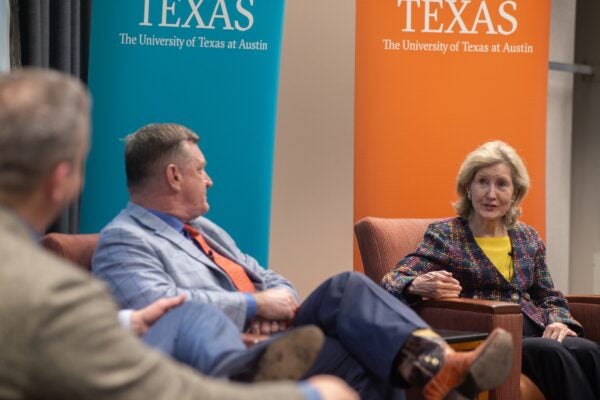This spring, I attended Energy Week, a conference cosponsored by UT’s Energy Institute and Kay Bailey Hutchison Energy Center. There, in the San Jacinto Residence Hall on the banks of Waller Creek, I heard dozens of speakers, faculty members, industry panelists and doctoral students explaining their work. I’m not going to lie: The student presentations were completely over my head, but I was glad to hear such smart people working on important problems.
There were things that I did understand and that I learned during Energy Week, and here are 10 of them:
1. We’re facing a huge shortage. Right now, Texas produces as much energy as California and New York combined. That’s a lot. But by 2030, Texas is going to need an additional California’s-worth of power. By some estimates, we need to double our power. That seems unlikely as it’s taken more than a century to get where we are. But it’s completely impossible without aggressively pursuing all forms of available energy. In the U.S., data centers are putting huge new demands on our energy supply, with the use of artificial intelligence and the emergence of cryptocurrency looming specters.We can question the necessity of those (a phenomenon known as induced demand), but unless something changes, we’re headed for severe shortages.
2. What an “energy quadrilemma” is. Energy has been in a trilemma for some years, the considerations of which are 1) cost, 2) reliability and 3) carbon intensity. According to Sanjay Bishnoi, CEO of Entropy Inc., there is really an energy quadrilemma, the fourth consideration being speed to market. Entropy is a Canadian carbon capture and storage company, and Bishnoi earned a Ph.D. at UT in chemical engineering. Each energy source can be plotted against these four variables. For instance, nuclear is great on reliability and carbon intensity, but it’s not good on cost and speed to market. Wind is good on cost and carbon intensity, moderate on speed to market, but weak on reliability. Natural gas is great on cost, reliability and speed to market, but not on carbon intensity, and that’s his business: capturing carbon from natural gas — before and after combustion — and storing it underground to prevent its escape into the atmosphere.
3. There’s never been an energy transition. So says Wil VanLoh, founder and CEO of Quantum Capital Group. There have only been additions. The first energy source was the burning of wood and dung. Coal began to power the industrial revolution in the 1840s. Oil use started in the 1910s with the onset of automobiles, gas with the additions of turbines in the 1930s, nuclear energy in the 1960s, and wind and solar starting in the early 2000s. Nothing in that mix to date has been phased out, though each region has a different mix. In fact, he said, last year was the peak year for usage in every one of those categories all the way back to burning of wood.
4. The oil and gas industry has long been supported by huge tax breaks put in place by Texans in Congress. George Seay, founder and chairman of Annandale Capital and grandson of the late Gov. Bill Clements (and who serves on the advisory boards of UT’s Clements Center and McCombs School of Business), said: “There’s a history to all of it, and it involves people. And the reason that the oil and gas industry has such incredible tax breaks and allowances and depletion and everything else is that Sam Rayburn (UT 1908) was speaker of the House for a very long time, and Lyndon Johnson was majority leader of the Senate and ramrodded that through the Congress, and it’s still there today. It’s dug in like a tick — you can’t get it out.”
5. We should go nuclear, quickly. The main challenge we face in renewables is that the Chinese have been circling the world locking up renewables, especially with regard to battery technology. “We shouldn’t even try,” said VanLoh. “We should leapfrog them on nuclear.” He added that oil companies ran a massive campaign to put nuclear energy out of business, “and it worked.” About 20% of energy nationally is nuclear. Bill Charlton, director of UT’s Nuclear Engineering Teaching Laboratory, thinks 60% of energy in the U.S. should be nuclear energy.
6. I learned that emeritus faculty members get to audit UT classes for free. I learned this because for two days I sat next to Harovel Wheat, who retired from our engineering faculty in 2015 and since then has taken 22 classes, most of them in religious studies. These have included “Myths and Legends of the Ancient Near East” and the “History of Christmas.” Wheat attends between six and eight week-long technical conferences a year in retirement. Wheat, who grew up in Tyler, is an expert on corrosion.
 7. There’s a World Theranostics Day. And it happened to be the day I heard the panel on nuclear medicine. Theranostics is a portmanteau (a mashup) of therapy and diagnostics. UT assistant professor Elena Zannoni, who teaches nuclear and radiation engineering in the Walker Department of Mechanical Engineering, explained that radioisotopes used for imaging can also be used for treatment at the same time. “See what to treat and treat what you see,” sums up this field of medicine. During the past six years there have been numerous approvals from the Food and Drug Administration. Now we’re seeing a second generation of radio-pharmaceuticals. Every day, there is activity with new radioisotope treatments moving through the FDA approval process.
7. There’s a World Theranostics Day. And it happened to be the day I heard the panel on nuclear medicine. Theranostics is a portmanteau (a mashup) of therapy and diagnostics. UT assistant professor Elena Zannoni, who teaches nuclear and radiation engineering in the Walker Department of Mechanical Engineering, explained that radioisotopes used for imaging can also be used for treatment at the same time. “See what to treat and treat what you see,” sums up this field of medicine. During the past six years there have been numerous approvals from the Food and Drug Administration. Now we’re seeing a second generation of radio-pharmaceuticals. Every day, there is activity with new radioisotope treatments moving through the FDA approval process.
 8. It takes 10,000 iPhone batteries to make one electric vehicle battery. So, if the future of transportation is the electric car, we’re going to need a whole lot of lithium. After buying and driving an electric car, Teague Egan became a believer not only in the EV revolution but the energy transition, and so started EnergyX, a lithium-mining company, in 2018. He has since acquired more than 100,000 acres in Bolivia for lithium mining. Even Exxon Mobil is building its lithium business.
8. It takes 10,000 iPhone batteries to make one electric vehicle battery. So, if the future of transportation is the electric car, we’re going to need a whole lot of lithium. After buying and driving an electric car, Teague Egan became a believer not only in the EV revolution but the energy transition, and so started EnergyX, a lithium-mining company, in 2018. He has since acquired more than 100,000 acres in Bolivia for lithium mining. Even Exxon Mobil is building its lithium business.
Lithium, a silvery-white metal in its pure form, can be mined in two main ways: rocks and brines. The largest rock deposits are in Australia. But the world’s largest lithium source is the Lithium Triangle formed by Chile, Bolivia and Argentina. There are now about 80 lithium extraction and technology companies. In the United States, the largest source of lithium-carrying brines is the Smackover, a formation more than a mile underground that runs from northern Florida to Texas. It’s named for the Smackover Oil Field discovered in 1922 in Smackover, Arkansas. But how did Smackover, Arkansas, population 1,600, get its name? When French settlers arrived in 1686, they noticed the area was covered in sumac bushes and so called it Sumac Couvert. Say sumac couvert three times fast and you’ll hear where the name came from.
9. We need a better place to put “produced water.” In addition to releasing oil and gas, hydraulic fracturing produces vast quantities of nasty groundwater. Currently this “produced water” is pumped back deep underground. It’s this reinjection of produced water — not the fracking itself — that can cause earthquakes by activating fault lines that have lain dormant for eons.
And we are talking about huge quantities: Drilling in the Permian Basin generates seven times as much water during a year as is used in Austin. So, what to do with this stuff?
This water cannot be simply pumped out onto the land’s surface to create lakes and wetlands because it’s a brine and so would kill just about any plants. “We’ve shown this water can be treated to a very high level,” where it could be used for other purposes, said Paul Barbour of Devon Energy. Mike Hightower, director and research professor at the New Mexico Produced Water Research Consortium, said that with desalination technology, we can recover half of the water we produce in the Permian Basin … “and if we’re not doing that, we’re the stupidest people on the face of the Earth. The oil and gas industry can lead the country in recycling water and driving us to a much better energy and economic perspective.”
 10. On that point, Shane Walker is thinking really big. Using it for industrial cooling is better than disposing of it, but with a little more research, air cooling could replace that. “Let’s not waste water on cooling. It’s a really low-value use of water,” Walker said. “What I would really like to see is water used for things that are really going to benefit the environment. A couple of hundred years ago when the bison were prominent in the Permian Basin, we actually had grasslands across that area. It does not look like that now. There’s been an ecosystem change that was largely anthropogenic; we decimated that. But I see an enormous opportunity here to reverse that. We could regenerate millions of acres of landscape in West Texas with the amount of water we’re talking about.” Walker, a professor of civil, environmental and construction engineering at Texas Tech, says it could change the microclimate of West Texas, actually expand agriculture in South Texas, and change the hydrology of Central Texas. “You could benefit millions of people. Let’s be strategic.” The trick is getting the salt out in an economically feasible way, and Walker has devoted much of his career to cracking that nut.
10. On that point, Shane Walker is thinking really big. Using it for industrial cooling is better than disposing of it, but with a little more research, air cooling could replace that. “Let’s not waste water on cooling. It’s a really low-value use of water,” Walker said. “What I would really like to see is water used for things that are really going to benefit the environment. A couple of hundred years ago when the bison were prominent in the Permian Basin, we actually had grasslands across that area. It does not look like that now. There’s been an ecosystem change that was largely anthropogenic; we decimated that. But I see an enormous opportunity here to reverse that. We could regenerate millions of acres of landscape in West Texas with the amount of water we’re talking about.” Walker, a professor of civil, environmental and construction engineering at Texas Tech, says it could change the microclimate of West Texas, actually expand agriculture in South Texas, and change the hydrology of Central Texas. “You could benefit millions of people. Let’s be strategic.” The trick is getting the salt out in an economically feasible way, and Walker has devoted much of his career to cracking that nut.
The Energy Institute can be reached at info@energy.utexas.edu.




